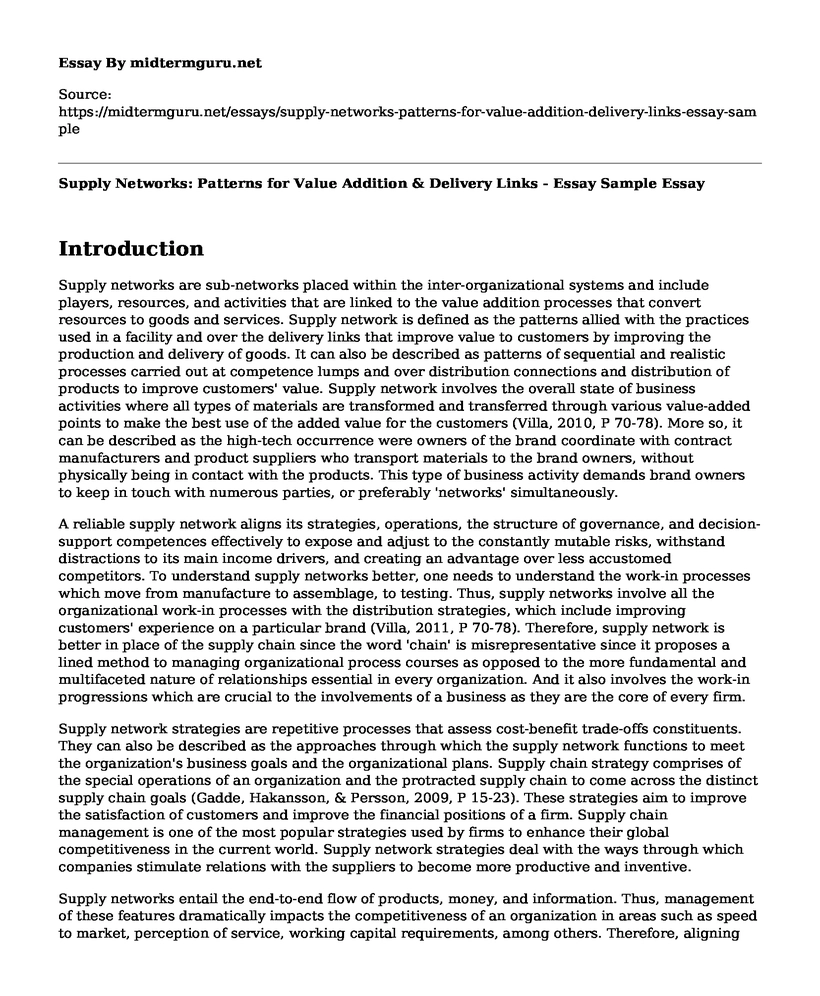Introduction
Supply networks are sub-networks placed within the inter-organizational systems and include players, resources, and activities that are linked to the value addition processes that convert resources to goods and services. Supply network is defined as the patterns allied with the practices used in a facility and over the delivery links that improve value to customers by improving the production and delivery of goods. It can also be described as patterns of sequential and realistic processes carried out at competence lumps and over distribution connections and distribution of products to improve customers' value. Supply network involves the overall state of business activities where all types of materials are transformed and transferred through various value-added points to make the best use of the added value for the customers (Villa, 2010, P 70-78). More so, it can be described as the high-tech occurrence were owners of the brand coordinate with contract manufacturers and product suppliers who transport materials to the brand owners, without physically being in contact with the products. This type of business activity demands brand owners to keep in touch with numerous parties, or preferably 'networks' simultaneously.
A reliable supply network aligns its strategies, operations, the structure of governance, and decision-support competences effectively to expose and adjust to the constantly mutable risks, withstand distractions to its main income drivers, and creating an advantage over less accustomed competitors. To understand supply networks better, one needs to understand the work-in processes which move from manufacture to assemblage, to testing. Thus, supply networks involve all the organizational work-in processes with the distribution strategies, which include improving customers' experience on a particular brand (Villa, 2011, P 70-78). Therefore, supply network is better in place of the supply chain since the word 'chain' is misrepresentative since it proposes a lined method to managing organizational process courses as opposed to the more fundamental and multifaceted nature of relationships essential in every organization. And it also involves the work-in progressions which are crucial to the involvements of a business as they are the core of every firm.
Supply network strategies are repetitive processes that assess cost-benefit trade-offs constituents. They can also be described as the approaches through which the supply network functions to meet the organization's business goals and the organizational plans. Supply chain strategy comprises of the special operations of an organization and the protracted supply chain to come across the distinct supply chain goals (Gadde, Hakansson, & Persson, 2009, P 15-23). These strategies aim to improve the satisfaction of customers and improve the financial positions of a firm. Supply chain management is one of the most popular strategies used by firms to enhance their global competitiveness in the current world. Supply network strategies deal with the ways through which companies stimulate relations with the suppliers to become more productive and inventive.
Supply networks entail the end-to-end flow of products, money, and information. Thus, management of these features dramatically impacts the competitiveness of an organization in areas such as speed to market, perception of service, working capital requirements, among others. Therefore, aligning the supply networks with the business strategies makes sure of the high level of business performance (Gadde, Hakansson, & Persson, 2009, P 15-23). Decisions made by every organization on where and how to locate a production and supply network have become a crucial part of a firm's global supply network strategy and are vital in obtaining the competitive advantages of an organization. Therefore, supply chain/network strategies are the processes that enhance the performance of a firm through the development of particular relations.
Reference
Gadde, L.E., Hakansson, H., and Persson, G. 2009. Supply Network Strategies - 2nd ed. pp. 15-23.
Villa, A. 2011. Managing Cooperation in Supply Network Structures and Small or Medium-Sized Enterprises: Main Criteria and Tools for Managers. pp. 70-78.
Cite this page
Supply Networks: Patterns for Value Addition & Delivery Links - Essay Sample. (2023, Jan 24). Retrieved from https://midtermguru.com/essays/supply-networks-patterns-for-value-addition-delivery-links-essay-sample
If you are the original author of this essay and no longer wish to have it published on the midtermguru.com website, please click below to request its removal:
- Group Discussion Analysis
- Evaluation Paper on Burberry
- Under Armour's Strategy in 2014 - Case Study
- Comparing Obama and Isocrates's Speech - Essay Sample
- Unlock Your Life with Internet: How Technology Has Changed the Way We Work - Research Paper
- Understanding Larry Ellison: A Study of OB Perspective - Essay Sample
- Leading Differently: Confucius' Checklist for Authority Figures - Essay Sample







